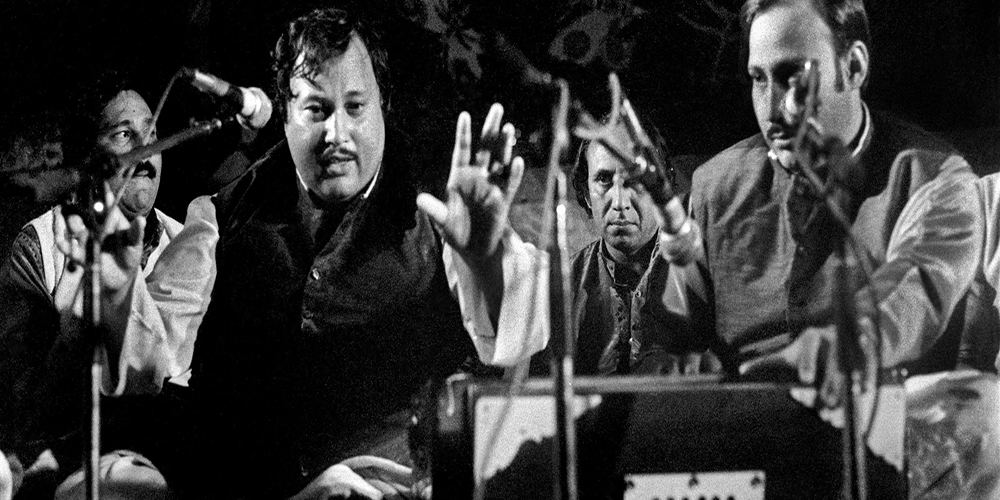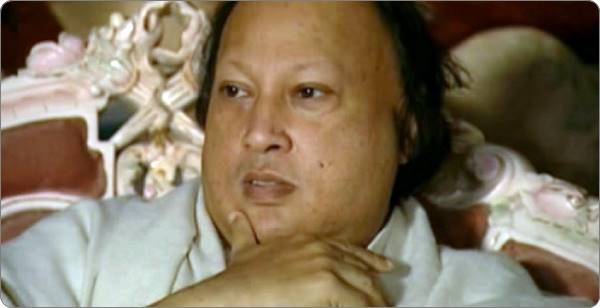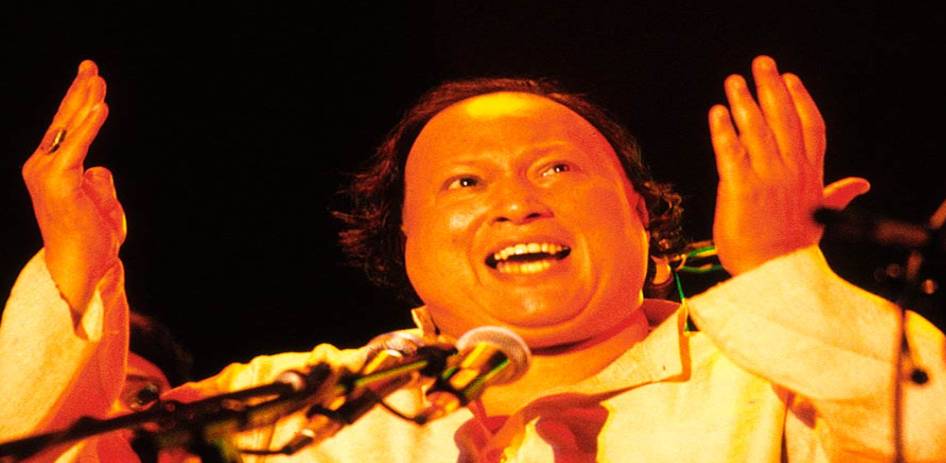
A man of superlatives: weight (impressive), octaves (six, supposedly), albums (125 at the beginning of the 1990s according to the Guinness book of records, maybe twice that many by now), videos that can be consulted on the Internet site YouTube (over 2,000, certain of which have been viewed a million times in a single year), concerts (by the thousands), Google references (hundreds of thousands), cassettes and CDs (by the millions).” Over the space of about 15 years, this chosen singer, one of God’s madmen, one of God’s sweetest, shot to planetary fame. Baud wrote, “Singing Buddha in Tokyo, Quintessence of the human voice in Tunis, The Voice of Paradise in Los Angeles, The Spirit of Islam in London, Pavarotti of the East in Paris, and Shahenshah-e-Qawwali in Lahore. Nusrat’s global appeal allowed him to perform in over 40 countries, and acquire many titles of honor. Nusrat Fateh Ali Khan and Famed Folk Singer, Jeff Buckley In terms of poetry, qawwali uses geet, ghazal, wasokht, doha, hamd, naat, qataa, musaddas, qissa, and virtually all genres of poetry. He also used alankars (ornamentation in music) that were universally known and popular, as opposed to ones that were exotic and esoteric.

Its structure is well-known and understood all over the world. Nusrat preferred the keherwa - or, more specifically, the qawwali taal invented by Amir Khusrau. He went on to explain that Qawwali has been sung traditionally in particular rhythmic cycles, like dadra, qulbana, bhajan, khayal, dhrupad, Tirwat, and Thumri. This is where Nusrat excelled and this is the primary reason, in my opinion, of his immense popularity.” This is an essential, if rare, trait in qawwals. Since the primary purpose of Qawwali is to transfer the message of love from the qawwal to the listener. The greatest strength of Nusrat qawwali was his ability to build an incredible rapport with his listeners. Nusrat chose poetic genres that large numbers of people understood and liked. In terms of poetry, qawwali uses geet, ghazal, hamd, wasokht, doha, naat, qataa, musaddas, qissa, and virtually all genres of poetry. Nusrat, however, primarily stuck to the geet and ghazal forms that were most popular. Qawwali has many forms like qalbana, qaul, hawa, gul, naqsh, nigar, baseet and also employs genres like geet, ghazal, khayal, tirwat, tarana, thumri, dadra, chaturang and many others.

He also used alankars (ornamentation in music) that were universally known and popular as opposed to ones that were exotic and esoteric. This help made his qawwali easy to appreciate all over the world and, hence, popular.

Nusrat preferred the keherwa - or, more specifically the qawwali taal invented by Amir Khusrau - whose structure is well known and understood all over the world. Qawwali has been sung traditionally in a number of rhytmic cycles like dadra, keherwa, sulfahta, roopak, jhaptal, ektala, farodast, arha chautala and teentaal. Ally Adnan, who writes and lectures about qawwali and classical music all over the world elaborated, “Nusrat popularized qawwali by making it accessible, understandable and relatable to listeners not only in South Asia but all over the world. I witnessed mainstream artists sitting on the floor, listening to Khan sahib’s Alaap (Vocal renditions) and writing songs for him then and there, synching western instruments with his compositions and voice.”Īs he matured as a performer, Nusrat made various adjustments to his style, such as increasing the tempo, as a means to elevate qawwali to a new level of aesthetic and spiritual resonance with contemporary and international audiences.
#Nusrat fateh ali khan qawali full
I have seen the largest and most prestigious venues across the world fill up to full capacity to listen to Khan sahib. Talking exclusively to Youlin, Khan’s nephew, prodigy, and a musical figure of global prominence in his own right, Rahat Fateh Ali Khan, who toured with his uncle’s qawwali troupe as a young disciple, recalls, “I have seen people around the world going into a state of transcendence without understanding a single word of a qawwali that Ustad Nusrat Fateh Ali Khan sang. Nusrat appeared as the most prominent flag bearer of South Asian sound. This was when world music was being established as a new category of sound, transcending geographical, linguistic, and cultural divides. His performance at the “World of Music, Arts, and Dance Festival, London” in 1985 introduced his genius to the global audience. Once he established himself as the greatest Qawwal the country has produced, Nusrat’s popularity started to spill across continents.

Nusrat Recording at Bidi Studios in Paris, 1993


 0 kommentar(er)
0 kommentar(er)
